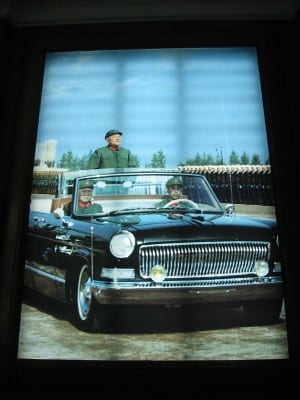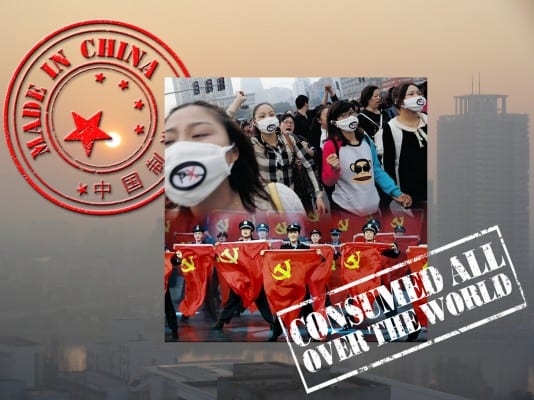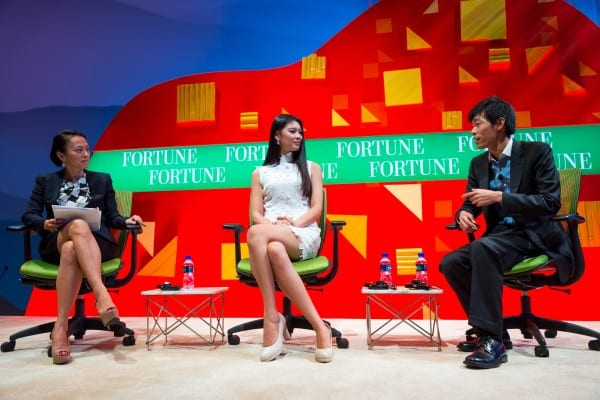China’s Second ‘Cultural Revolution’
JAMES PETRAS | indispensable reads
From the author’s site
(Originally posted 12.23.2014 :: Analysis)
President Xi is attacking the triple evils of corruption, conspicuous consumption, and pillage of public wealth.

Billboard tribute to Deng Xiao ping, Shenzhen, China on a busy Saturday afternoon, Jan. 2010. (Douglas Johnson, flickr-cc)
CLICK ON IMAGES TO EXPAND
[dropcap]Introduction[/dropcap] ![]()
![]()
The first CR was a frontal attack on the hierarchy of power and privilege inside and outside of the Communist Party, launched from above by Mao Tse Tung, but taken up from below by Red Guards in order to bring about a more egalitarian society.
The current ‘cultural revolution’, launched by President Xi Jinping, is directed at ending widespread corruption, theft and pillage of the Chinese economy and society by high and low officials in government and the capitalist sector.
The two cultural revolutions are linked by Deng Xiaoping, the Chinese leader who officially put closure on the first and set in motion the policies and slogans (“Getting Rich is Good!”), necessitating a second cultural revolution three decades later.
The Socio-Economic Roots of the Cultural Revolution Today
Deng’s call to ‘get rich’ was directed at the Communist Party elite, their family, friends and overseas backers; it was an open invitation to the multi-nationals of the world to freely exploit China’s resources, infrastructure and labor – educated, nurtured and organized through the collective efforts of the preceding Communist regime. Deng ‘liberated’- or privatized – the means of production and rapidly turned public control and appropriation of earnings over to emerging private capitalists. The corollary was the elimination of all social rights, benefits and protections of labor. The dual incentives were designed to maximize private profits in order to attract long-term, large-scale investments and to achieve high growth in the shortest time possible. Deng telescoped a century of growth and exploitation into a few decades.
His strategy succeeded.

Deng Xiao Ping, picture in the Revolutionary Army Museum. Deng was originally in trouble with Mao for his “capitalist- roader” tendencies. (Marcin Palka/cc/flickr)
Profits soared. By the late 1980’s and early 1990’s millionaires multiplied like mushrooms after a downpour. Then came the billionaires. Aided and abetted by the wholesale privatization of lucrative industries and public lands, a new class of real estate speculators and so-called ‘developers’ emerged , closely linked to corrupt local municipal, regional and national state officials. Millions of peasants were dispossessed and barely (if ever) compensated; hundreds of millions of workers were employed at starvation wages without the free housing, medical care, education, recreational benefits and lifetime employment of the past, socialist system.
China’s GNP exploded at a double-digit rate for three decades – an unprecedented performance. Most of the profits circulated among a narrow elite of party – state officials and capitalists, while a smaller share ‘trickled down’ to middle and low level functionaries. The seizure of public wealth, followed by three decades of intense exploitation of labor and the private land grabbing of farmland and homesteads, spurred the boom in real estate profits and laid the basis for all pervasive and large-scale corruption .The pillage of the public treasury led to large-scale conspicuous consumption – of imported luxury goods, multi-tiered mansions in gated communities, multiple purchases of luxury condos for offspring, mistresses and bribe-takers and givers.
By the mid 2000’s the concentration of wealth, property and privilege had reached astronomical heights: hundreds of billions accrued to the top 2%, millions to the top 10%, and hundreds of thousands to the top 15% – the self-styled ‘middle class’ who thrived on lesser but equally pervasive corruption and theft and who aped the elite and imitated their life style of luxury consumerism.
Beginning in the mid-2000s, hundreds of strikes by exploited factory workers demanded and secured higher wages; millions of households, farmers and peasants fought against municipal party officials, linked to real estate capitalists, who were attempting to ‘grab’ their land, homes and neighborhoods. Hundreds of millions of Chinese in the countryside protested exorbitant medical and educational costs, induced by the privatized health and educational system, which had bankrupted millions of households. They quickly became aware of the luxurious private medical facilities and specialized clinics for the rich -capitalists and corrupt officials. The internal migrant workers, who built the hyper-luxury condos and mansions, lived in paper shacks, far from the twelve-course banquets celebrating the ‘grand openings’ by business swindlers and ‘bought officials’. As wealth grew among the elite, so did the people’s hostility and rejection of the Party and the State, which they personified.
The ever-cautious klepto-capitalists and public pillagers, fearing for their illicit fortunes, smuggled out enormous wealth. Big swindlers, with big fortunes engaged in massive money laundering while publicly demanding the ‘de-regulation” of the financial sector (i.e. to make it easier to launder and hide their fortunes in overseas accounts). Between 2005-2011 China hemorrhaged over $2.83 trillion in illegal overseas financial outflows.
Part II: The Consequences of Corruption, Pillage and Exploitation
The illicit flow of Chinese wealth overseas resulted from the elite’s savage and illegal exploitation of labor (failure to meet minimum official standards concerning pay, work safety, child labor, excessive hours) . Wealth from bribes, kickbacks on government contracts, speculation on illicit seizures of land, and making false invoices overpricing imports and underpricing exports, flowed upward and outward. While China was profiting from double-digit growth the regime could ‘tolerate’ corruption and illicit outflows. However, by the beginning of the second decade of the 21st century, when China’s economy de-accelerated to about 7 – 7.5%, the regime became less tolerant of wholesale corruption accompanied by capital flight.
Moreover, the new billionaires, millionaires and affluent middle class indulged in what Thorsten Veblen described as “conspicuous consumption”, the purchase and ostentatious display of superfluous luxury products as status symbols of “success”. According to a Special Report on “Luxury” in the Economist (12/13/14, p.8 -10) “nearly one-third of all personal luxury goods sold worldwide are bought by Chinese consumers.” Since the global crises of 2009, 70 – 80% of global growth in the (luxury) sector has come from China.

Photo: Kevin Lim/cc-flikr.
China’s emerging private-public ruling class has advanced from concentrating wealth, to consolidating political power to seeking prestige and social status – recognition from their domestic and foreign peers. Ideologically, they are decidedly neo-liberal and pro-Western – as evidenced by the billions they spend in the top-end real estate markets of North America, Europe and Australia as well as the millions they spend on their pampered offspring for ‘elite’ private education. Theirchildren live in half-million dollar condos in Cambridge, Massachusetts, Oxford and Cambridge (England), Toronto and Vancouver (Canada), Sydney and Melbourne Australia. The Chinese oligarchs “make the market” for six-figure Swiss watches, five figure handbags and four digit French cognac.
Corruption, conspicuous consumption and class polarization has delegitimized the ruling Communist Party elite in the eyes of the great mass of the Chinese working class, as well as the professionals and salaried employees who make-up the lower middle class.
The ‘political rot’- the privileged social networks derived from kinship ties—is leading to a relative-closed ruling class – excluding the mass of urban workers and rural peasants, with potentially explosive social consequences.
Already thousands of local protests, strikes and other forms of direct action occur every year, even as they are repressed or resolved.
In addition to the social and political dangers resulting from the massive illegal, ‘squandering and theft of wealth’, the illicit outflow of wealth is undermining domestic investment and productive overseas investments, and corruption is preparing the way for stagnation and financial crisis.
The stars are lining up for a ‘perfect political storm’ – which has unfolded in the form of President Xi Jingping’s launch of China’s second cultural revolution (CR).
Xi Jingping’s Cultural Revolution
From the start of the 2nd CR in 2012 to mid-2014, the Chinese Communist Party’s internal corruption body has prosecuted and punished 270,000 cadres. That figure includes both the “tigers” (high officials) and the “flies” (low level functionaries). “Over three dozen officials with ranks of ministers or above, including former security Tsar and Politburo Standing Committee member Zhou Yongkang”, have been arrested and jailed (Financial Times 12/4/14, p. 4). Earlier, the former Railways Minister was arrested and sentenced to death for rigging contracts worth about $26 billion dollars over his seven-year tenure. Hundreds of thousands of private business people, paying bribes, have been arrested and sentenced.
President Xi’s campaign has attacked bribes, ‘gift giving’, frequent ostentatious banquets serving expensive delicacies, and high Party officials’ lodging in five star hotels for weeks on end, ostensibly “tending to business”, but more frequently ‘cavorting with their mistresses’.

Made in China—Consumed all over the world—at high cost to the people and environment of China. (cc/Flickr)
To be precise, President Xi is attacking the triple evils of corruption, conspicuous consumption, and pillage of public wealth. The new austerity agenda and the public revelations of ill-gained wealth are focused on exposing public officials and private business people in order to regain public legitimacy. And it is succeeding,…. as far as it goes. Public indignation at the revelations is matched by high approval for the Xi leadership’s anti –corruption campaign.
What makes this far more than just a “power struggle among privileged elites” as the Wall Street Journal and the Financial Times have routinely claimed, are: 1. the duration of the campaign of over 2 years, 2. the scope of the campaign, covering top officials and Chinese business equivalents of Wall Street moguls, 3. The nature of the punishment including long prison terms and even death sentences (rather than the mere ‘slap on the wrists and paltry fines’ that US regulators have given to Wall Street’s billion-dollar swindlers), and 4. the ongoing nature of the process. The sweep and magnitude of Xi’s campaign has all the makings of a ‘cultural revolution’ – not the episodic ‘blowing off steam’ or ‘scapegoating of rivals’ described in the Western press.
The Nature of Xi’s Cultural Revolution
Xi’s ‘cultural revolution’ is directed and driven from above – established legal authorities are in charge – the masses are excluded, and preemptory justice is eschewed: regular court proceedings decide guilt and sentencing.

A sliver of the population has grown accustomed to consumerism. (Photo: Flickr/cc)
Secondly, Xi’s ‘cultural revolution’ does not, in any way or place, call into question capitalist property relations, foreign investors, or large-scale inflows and outflows of investment or legally registered speculative capital. Nor has Xi called into question existing capital-labor relations.
Xi’s ‘cultural revolution’ is an attempt to sanitize existing capitalist relations, and to infuse a newcapitalist ethic. He wants to ‘revise’ Deng’s famous precept “Getting Rich is Good” to read “Get Rich Lawfully . . . or Face Jail”. China is rated number 100 out of 175, on a corruption scale published by Transparency in 2014 (Financial Times 12/4/14, p. 4). Xi’s war on corruption is based on the premise that corruption undermines China’s status as a global power – it ranks with Algeria and Surinam. Secondly, Xi hopes that he can ‘reform’ the public sector in order to privatize it and he wants the sale to go to the highest bidder, not the biggest bribe giver.
His campaign attacks privileged elites, who accumulate and dispose of wealth illegally but he has never sought to diminish the class system, the hierarchy and inequalities which concentrate political power and forms the basis of corrupt bribe giving and taking.
Xi’s ‘cultural revolution’ is continuing and corruption may lessen. Ostentatious public spending is declining. But this layer of ‘new morality’ is spread thinly over a system of power that can easily revert to the ‘old system’ once the ‘revolution’ ends.
Xi’s noteworthy ‘cultural revolution’, the moralization of public administration and private capitalism, can only succeed if it is accompanied by a social transformation: ethics at the service of social justice and equality and by a democratization of the economic decision-making process. The problem is that Xi, by family, social ties and political allegiances is deeply embedded in a milieu which absolutely rejects any such ‘deepening’ of Xi’s ‘cultural revolution’.
His cultural revolution is strictly guided by a singular objective: to force ‘morality’ on the ‘captains of capital’ in order to facilitate the smooth transition to fully liberalizing China’s economy. President Xi, along with his anti-corruption campaign, is steadily loosening state control over foreign financial investments in Chinese stocks and financial sector; he is moving strongly to expand China’s overseas investments; he is accelerating the privatization of public enterprises and increasingly opening financial services to Wall Street and the City of London. He is also internationalizing the use of the yuan-the Chinese currency- in global transactions, displacing the dollar.
In other words, his cultural revolution is a bridge to a new stage of Chinese capitalist expansion; it will lessen the crude open plunder of the public treasury, but it will not lessen the exploitation of labor nor slow the increasing concentration of wealth and privilege. That will require a different kind of ‘cultural’ revolution- one led from below by workers, peasants and salaried employees. A real ‘cultural revolution’ that realizes the ethical ideals of ‘good government’ through a transformation of class relations.
Xi’s anti-corruption campaign confirms what many workers already knew – but it also unmasks the systemic decay and forges an elementary class consciousness: counter-posing honest, hardworking workers to corrupt privileged oligarchs. Xi is aware of the danger that his campaign could ignite a popular fire: That is why he has kept a tight hold on the process. He is trying to navigate the liberal capitalist transition around the shoals of existing capitalist rot without arousing mass unrest.
And now a word from the Editors of The Greanville Post
FRIENDS AND FELLOW ACTIVISTS—
AS YOU KNOW, THERE’S A COLOSSAL INFORMATION WAR GOING ON, AND THE FATE OF THE WORLD LITERALLY HANGS ON THE OUTCOME.
THEIR LIES.
THEIR CONSTANT PROPAGANDA.
OUR TRUTH.
HUGE ISSUES ARE BEING DECIDED: Nuclear war, whether we’ll live in democracy or tyranny, dignity or destitution, planetary salvation or doom…It’s a battle of communications we can’t afford to lose.
So, we request that you do something.
Reading is not enough. Action of some sort is needed.
Start with something simple: Share our posts.
If you don’t, how can we ever neutralize the power of the corporate media?
And if you took the time to read this article, and found it worth SHARING, then why not sign up with our special bulletin to be included in our future distributions? And please tell others about The Greanville Post.
YOUR SUBSCRIPTIONS (SIGNUPS TO THE GREANVILLE POST BULLETIN, SEE BELOW) ARE COMPLETELY FREE, ALWAYS. AND WE DO NOT SELL OR RENT OUR EMAIL ADDRESS DATABASES—EVER. That’s a guarantee.